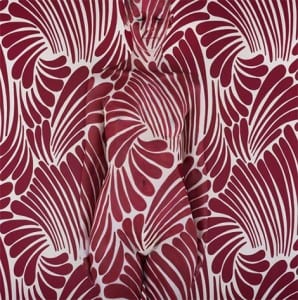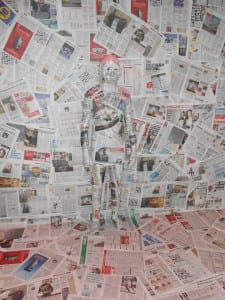To many passers-by the Grandstand goes unnoticed, it fades into the background, it becomes hidden in plain sight. So as we think that the Grandstand has lost its identity, we want to bring it back to life and to bring back its former glory. So taking the idea of something being hidden in plain sight we looked at the idea of filling a wall or even an entire room with newspaper pages, and then also completely wrapping ourselves in the newspaper too- in order for us to blend in with the background, to become camouflaged, and to ‘lose our identity’. We looked at a couple of other artists who use a similar concept before trying it out for ourselves. We had seen the idea be used recently in a music video for Gotye’s ‘Somebody that I used to know’, where the singers had their bodies painted to match the background behind them. The artist who helped design this was called Emma Hack, who explores the notion of camouflage in her work, and was inspired and influenced by the work of Veruschka (an artist who camouflaged herself into rustic walls and environmental settings in the 1960s and 70s). Looking more closely at artists who use this same concept but for site-specific performance, we found Christo and Jeanne-Claude. This couple have done similar pieces of art but instead of using camouflage, they wrapped items, people and buildings in material to draw attention to and to create intrigue and mystery of the wrapped piece. By wrapping the building it “compel[s] us to look anew at our everyday surroundings” ((Allain, P. and Harvie, J. (2006) The Routledge Companion to Theatre and Performance. Oxon and New York: Routledge. P36)) and as quoted on the Christo and Jeanne-Claude website “The concealment caused by the fabric challenges the viewer to reappraise the objects beneath and the space in which it exists” ((Blackbourn, A. 2011, www.christojeanneclaude.net/projects/wrapped-objects-statues-and-women?view=info)). We want the spectator to see the Grandstand properly, as opposed to just letting it fade into the background as they drive past.
The following photos show an example of Emma Hack’s work, and also our first attempt at using newspaper to camouflage a person, in this case me.

Emma Hack’s work. ((Emma Hack, Wallpaper 2008 Collection. http://www.emmahackartist.com.au/emma_art/emma_wallpaper08.html))
Whereas Christo and Jeanne-Claude wrap the outside of buildings, we have reversed this and will be wrapping the inside of the building. And whereas they use plastic to wrap the buildings, we have chosen to use newspaper. We chose to use newspaper for the reason that it creates a link to the media which constantly broadcasts adverts for gambling and betting, and also covers the horse racing when it takes place. Another reason we chose to use the newspaper, was because of an old article we found. As part of our research we took a visit to the Museum of Lincolnshire Life, and here we found an old newspaper article that was about some riots that had taken place at the Grandstand back when it was open. The article detailed numerous pick-pocketing incidents that had eventually led into full scale riots. The article was written in a very poetic style, and we really like the idea of including it somehow in our performance. We also liked the fact that it brings in the theme of loss, something of which we have spoken about in my group. Spectators at the Grandstand would have lost money when placing bets, they lost money through being pick-pocketed, and then the Grandstand lost its purpose altogether. This is a theme which we would like to recur throughout our piece.
Alongside this camouflage idea, and working to a similar theme of ‘loss’, we have been looking at using a poem called ‘the horse that I am riding’ written by Ric S. Bastasa. The short poem is written from the jockey’s point of view, and ends with the line “the horse gets nothing”, which we liked as it links to the Grandstand which now is nothing compared to what it was 70+ years ago. The poem creates a direct link with the site, as it revives the grandstand’s original purpose of being a ground for horse racing events. We played around with different ways of delivering the poem- having one person speak it, having us all speak it in unison, and lastly us all speaking it in canon. The last way we felt worked the best, as we realised it almost replicated the sound of galloping horses in a race.
In an exercise we have done recently, we stuck post-it notes over our mouths with words describing the ‘lost’ nature of the present grandstand written on them. We then slowly tore them off and dropped them to the floor. This action became almost reminiscent of the old betting slips that would have been thrown to the floor when they hadn’t won at the races. This, we thought, was really simple but powerful and we endeavoured to include it in our piece. So we decided that whilst we were reciting the aforementioned poem, we would drop ripped up bits of newspapers and possibly betting slips on to the floor. So that the floor would end being littered with scraps of paper, in the same way that it would have been littered with betting slips in the past.
We have also had the idea of projecting the first moving picture, which was of a horse and was created by Eadweard Muybridge, on top of us whilst we are camouflaged in the newspaper and whilst we are reciting the poem. However this idea still needs to be put into practise to see how well it works, and will be explored over the coming weeks.

I read a lot of interesting articles here. Probably you spend
a lot of time writing, i know how to save you a lot of work, there is an online tool that
creates unique, SEO friendly posts in minutes, just type in google – laranitas free content source